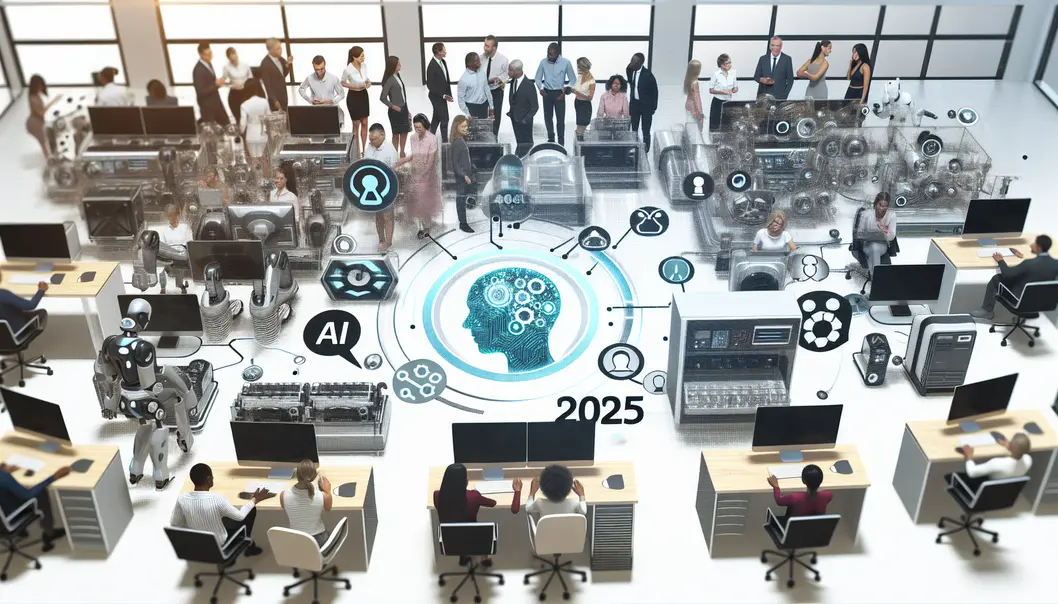As we look toward 2025, the promise of AI tools improving employee productivity is more relevant than ever. Despite challenges in getting detailed research, it remains vital to understand how AI can shape a more efficient future. Through exploring the technical challenges, data unavailability, research barriers, and technological dependencies, we’ll uncover how AI tools can transform the workplace environment.
Navigating Technical Setbacks: Overcoming Research Tool Limitations

In the swiftly evolving landscape of technological exploration, researchers often find themselves at the mercy of their tools. When these tools falter, the effects reverberate through the entirety of their work, influencing timelines, efficacy, and the breadth of insights attainable. The technical glitches encountered during our investigation into the pivotal role of AI tools in enhancing employee productivity by 2025 serve as a poignant reminder of our dependence on these systems.
Research in contemporary settings is increasingly intertwined with complex digital frameworks designed to streamline data acquisition, processing, and analysis. However, these systems are not infallible. When a research tool malfunctions, as experienced in our recent inquiry, it underscores a crucial vulnerability. These setbacks necessitate both immediate responses and long-term strategic thinking to mitigate future disruptions.
At first glance, the malfunction of a research tool may appear as a simple technical hiccup. Yet, when delved into deeply, it presents a significant hindrance that affects research progression. Without access to reliable data retrieval systems, researchers are left straddling the uncomfortable divide between incomplete information and the pressing demand for comprehensive insights. This predicament can stall projects, skew results, and obscure the clarity that data-driven research seeks to provide.
Moreover, such technical difficulties challenge researchers to explore alternative methodologies. In the absence of the primary research tool, reliance shifts towards secondary sources, which may not always offer the depth of detail desired. This reliance underscores the importance of flexibility in research approaches and the need for a diversified toolkit that can adapt when one element fails.
Despite these challenges, setbacks offer an opportunity for innovation. They encourage exploring novel approaches, like revisiting qualitative analyses or employing cross-disciplinary methods that might otherwise go unconsidered. This adaptability is particularly pertinent when facing an innovative field such as AI, where rapid development frequently outraces formal research methodologies.
While addressing malfunctions on a technical level is crucial, it is equally important to recognize the broader systemic patterns at play. Organizations conducting research must invest in robust infrastructures that anticipate potential pitfalls in their technical ecosystems. This includes developing redundant systems, training staff to troubleshoot effectively, and ensuring access to a variety of tools that can fill the gap when primary systems falter.
Furthermore, the continual presence of tech issues in research tools stresses the value of collaboration. Partnering with other organizations or teams can provide access to alternative resources and help develop novel strategies to circumvent current limitations. Such alliances are invaluable, particularly in speculatively rich territories like AI, where the quest for knowledge is both boundless and fraught with practical challenges.
Ultimately, the pursuit of insights into how employees utilizing AI tools could revolutionize productivity by 2025 faces an unexpected hurdle. Yet, as with any formidable challenge, it is an invitation to reassess, innovate, and envision alternative paths forward. Embracing this mindset can transform technical obstacles into catalysts for broader, more inventive approaches to research. For further insights on how technology reshapes industries, consider reading about transforming workplaces and businesses by 2025.
Navigating the Unseen: Challenges in Accessing Research Data

In the realm of academic and technical research, encountering obstacles like the temporary unavailability of vital research tools can significantly disrupt the workflow. Such technical disruptions are not mere inconveniences but rather pivotal moments that can redirect or delay the trajectory of research endeavors. They bring to light the critical nature of having reliable and accessible tools for data collection and analysis.
When attempting to explore the promising topic of how AI tools are set to boost productivity in 2025, we encountered a technical roadblock: the key research tool we intended to use was unavailable. Whether due to service disruptions, maintenance schedules, or unforeseen technical glitches, this challenge is unfortunately common in the digital research landscape. As researchers, understanding these hurdles and adapting to them is crucial for maintaining momentum and achieving our research objectives.
The Ripple Effects of Accessibility Issues
The inability to access research tools for even a short period can produce significant discrepancies in data continuity and even skew results if alternative methods are employed mid-research. Unearthing comprehensive analyses and detailed insights becomes challenging, especially when specific tools are central to collecting objective data. Additionally, these disruptions can lead to postponed deadlines, budget overruns, and unforeseen logistical challenges, emphasizing the intertwined nature of technology and research.
Researchers often find themselves in a reactive position, forced to quickly identify and utilize alternative modes of data collection. This might include leveraging various databases or even manually aggregating information that automated tools would otherwise handle with ease. However, this adaptation comes with its own set of challenges. Manual processes can be time-consuming and prone to human error, while alternative tools may bring about compatibility issues or lack the comprehensive features of their primary counterparts.
Adapt and Overcome: Strategies for Continuity
Facing such challenges proficiently requires a toolkit of strategies and contingencies that researchers can rely on to mitigate the impact of these disruptions. A proactive approach might involve maintaining backups of critical systems and having a suite of secondary research tools at the ready. Moreover, building a network of collaborators who can provide access to alternative resources or data becomes invaluable.
Leveraging interdisciplinary resources can be a powerful strategy. For instance, insights gathered from AI’s role in transforming workplaces offer resilient analogies for overcoming such hurdles. According to an enlightening discussion found here, the integration of AI into workflows not only enhances productivity but also builds resilience against similar disruptions.
In conclusion, navigating the unpredictable nature of research tools entails more than just technical expertise—it requires a mindset geared towards innovation, flexibility, and resourcefulness. By integrating these qualities into their workflows, researchers can not only survive these disruptions but also emerge with stronger, more adaptable methodologies. Thus, while technically unavailable research tools can certainly stall the process, they also present an opportunity to evolve and refine our approach to research in this increasingly digital world.
Navigating the Labyrinth: Overcoming Barriers to Research Access

In the digital age, the promise of unlimited access to information holds immense potential for researchers across the globe. However, technical barriers often stand in the way, hindering the smooth flow of research processes and limiting the accessibility of essential tools. The challenges of accessing and utilizing these research tools can be a significant roadblock, particularly when those tools malfunction or become unavailable unexpectedly.
At the core of these barriers lies the intricate workflow of research tools that promise comprehensive data retrieval and analysis capabilities. When such tools fail, researchers find themselves at a crossroads, searching for alternative approaches to gather necessary information. This was the case during our attempt to explore how employees using AI tools might boost productivity by 2025. The unavailability of a key research tool hindered our efforts to investigate this timely topic. Researchers often rely heavily on digital tools to manage data, analyze trends, and formulate hypotheses, making their inaccessibility a glaring issue.
The technical difficulties experienced can often stem from varied sources. System outages, which may occur due to software glitches or server downtimes, render digital research platforms temporarily unusable. Furthermore, restrictive access due to subscription models or paywalls presents another layer of complication, especially for researchers without institutional backing or extensive funding. This has prompted a re-evaluation of how technology dependence affects our ability to conduct research.
In scenarios where primary tools fail, researchers might have to pivot to traditional methods, such as library archives or physical records, which can be less efficient and more time-consuming. The increase in such occurrences raises the question of how reliant we should be on technology-driven research methods and whether there is a need to diversify our approaches to information gathering. Exploring alternative avenues, such as cross-disciplinary collaborations or community-based research, could provide insights otherwise hidden by technical barriers.
The rise of AI by 2025, as detailed in various insightful analyses, further complicates the scenario with advanced, yet complex, tool ecosystems. These AI-driven platforms promise greater productivity but also present novel challenges. As AI evolves, its integration into research processes must be managed carefully to maintain consistency and reliability. Addressing these barriers involves both technical solutions—such as creating more robust, user-friendly interfaces—and policy measures, like improving accessibility and affordability for all researchers.
Ultimately, navigating the labyrinth of research access requires a multifaceted approach that combines technical resilience with strategic planning. By anticipating potential disruptions and preparing alternative routes, researchers can continue to explore new frontiers of knowledge. Engaging with the broader community to share resources and expertise can also prove beneficial when roadblocks arise. As we look forward to an era increasingly dominated by AI, let’s focus on building systems that empower researchers, keeping the journey towards knowledge discovery as seamless and accessible as possible.
Relying on the Virtual Lifeline: Navigating Technological Access in Research

In the digital age, our ability to conduct research and harness data rests heavily on reliable technological access. This dependence can lead to significant challenges, particularly when these technologies falter. Such issues became apparent during our recent investigative effort on ‘Employees using AI tools boost productivity in 2025.’ The unavailability of the requisite research tools revealed just how vulnerable and dependent our workflows have become.
Technological access dependence is more than just a bottleneck; it’s a symbiotic relationship that modern researchers must navigate carefully. This reliance is born out of the convenience and power that advanced tools bring to research operations. From AI-driven data analysis to vast online databases, the scope and speed of modern research owe much to technological tools that, when inaccessible, can halt or severely cripple progress.
One of the primary implications of such dependence is the risk of data inaccessibility. When technical issues arise, they not only delay research but can also impact the quality of information procured. Imagine a librarian losing access to vast archives—it stalls the process of discovery and knowledge dissemination. The rise of AI automation has transformed workplaces, but with this transformation comes the responsibility of ensuring robust maintenance and backup systems to mitigate outages.
Another consequence is the potential for increased costs and resource allocation toward technological maintenance rather than pure research. Institutions and researchers must invest in sophisticated IT support structures and redundancy measures to guard against system failures. This means rethinking budget allocations, possibly at the expense of other areas of research funding. While some institutions may absorb these costs, others, perhaps in less economically endowed regions, may find this to be a significant barrier to entry into the cutting-edge research that technology enables.
Moreover, this dependency affects the collaboration landscape. When systems fail, so does the seamless sharing of knowledge and resources among global research networks. With contemporary research being highly collaborative and often cross-border, any technological disruption could regress advancements in shared efforts, slowing down the time it takes to achieve research milestones and discoveries.
Lastly, technological access dependence prompts a discussion on how we teach and prepare future generations of researchers. As reliance on technology grows, so should our educational curriculums to include training for handling technical disruptions adeptly. Preparing researchers not just in their fields of study but also in digital resilience can contribute substantially to minimizing downtime during technical difficulties.
As we look toward future research endeavors, ensuring resilience in the face of technological dependence is imperative. This requires robust strategies encompassing regular system updates, developing fallback methods for essential tasks, and fostering environments that emphasize adaptability. Therefore, while access to state-of-the-art technology is pivotal, the ability to work around its potential fallibilities is equally crucial for a sustainable research future.
Final thoughts
As we delve into AI’s potential by 2025, we see that while there are challenges, unlocking AI’s power can drastically improve productivity. Recognizing and overcoming these hurdles will guide us towards a future where AI plays a key role in making work more efficient and rewarding.
Elevate your business with Dream Team Media—your partner in AI-driven consulting, intelligent brand strategy, innovative product design, and cutting-edge web development.
Learn more: https://dreamteammedia.com/#contact/
About us
At Dream Team Media, we help businesses like yours unlock efficiency, streamline operations, and accelerate digital growth with AI-driven automation and intelligent strategy. Whether you’re struggling with time-consuming workflows, complex system integrations, or the need for a stronger digital presence, our expert team delivers tailored solutions to meet your unique challenges. By combining cutting-edge automation with innovative web development and data-driven insights, we empower you to work smarter, scale faster, and stay ahead in today’s competitive landscape. Let us help you turn your vision into reality with seamless, technology-driven solutions.